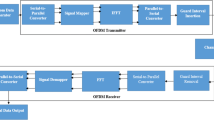Abstract
A peak-to-average power ratio (PAPR) reduction scheme with low complexity is proposed for the multicarrier spread spectrum (MC-SS) system in personal area network (PAN). Traditional clipping and filtering scheme requires a high oversampling rate to meet the emission mask requirements. This would cause high power consumption for mobile PAN devices in personal network. To solve the problem, upsampling is introduced between clipping and filtering in this paper to reduce the oversampling rate. A simplified implementation structure is also derived for the proposed scheme. Simulation results show that its complexity is about 65% of the conventional scheme while achieving satisfying performance.
Similar content being viewed by others
References
Schoo, K., Choi, H., Fazel, M., Dalhaus, D., Mutti, C., et al. (2005). MC-SS for personal area networks—A combined PHY and MAC approach. 14th IST Mobile and Wireless communications Summit, Dresden, Germany, pp. 19–22, June 2005.
My personal Adaptive Global NET. [Online]. Available: http://www.ist-magnet.org (accessed 29 September 2007).
Lampe M., Rohling H. (1999). Reducing out-of-band emissions due to nonlinearities in OFDM systems. Proceedings of IEEE VTC, Houston 45(5): 2255–2259
Paterson K.G., Tarokh V. (2000) On the existence and construction of good codes with low peak-to-average power ratios. IEEE Transactions on Information 46(6): 1974–1986 Technology in Biomedicine.
Tarokh V., Jafarkhani H. (2000). On the computation and reduction of the peak-to-average power ratio in multicarrier communications. IEEE Transactions on Communication 48: 37–44
Ochiai H., Imai H. (2002). Performance analysis of deliberately clipped OFDM signals. IEEE Transactions on Communication 50(1): 89–101
Suraweera, H. A., Panta, K. R., Feramez, M., Armstrong, J., et al. (2004). OFDM peak-to-average power reduction scheme with spectral masking. CSNDSP 2004, UK, July 2004. Available: http://www.ctie.monash.edu.au/ofdm/publications.html (accessed 29 September 2007).
IST-507102 MAGNET (2004). PN Architecture Requirements and State-of-the-Art Analysis Document. MAGNET WP2 Milestone M2.1.1, June 2004.
IST-507102 MAGNET (2004). Candidate Air Interfaces and Enhancements. MAGNET WP3 Deliverable D3.2.2a, Dec. 2004. [Online]. Available: http://www.ist-magnet.org/public+deliverables/phase1wp3 (accessed 29 September 2007).
IST-507102 MAGNET (2005). Update D3.2.2a ‘Candidate Air Interfaces and Enhancements’. MAGNET WP3 Deliverable D3.2.2b, Dec. 2005. [Online]. Available: http://www.ist-magnet.org/public+deliverables/phase1wp3 (accessed 29 September 2007).
IEEE Std. 802.11a-1999[S]. Part 11: Wireless LAN Medium Access Control (MAC) and Physical Layer (PHY) specifications: High-speed Physical Layer in the 5 GHz Band.
ETSI TR 101 475, v.1.3.1 (2001). Broadband Radio Access Networks (BRAN); HIPERLAN Type 2; Physical (PHY) layer. Dec. 2001.
IEEE Std. 802.15.3 (2003). Wireless medium access control (MAC) and physical layer (PHY) specifications for high rate wireless personal area networks (WPAN). Sep. 2003.
Niemegeers I.G., Heemstra de Groot S.M. (2002). From personal area networks to personal networks: A. user oriented approach. Wireless and Personal Communications 22(2): 175–186
Author information
Authors and Affiliations
Corresponding author
Rights and permissions
About this article
Cite this article
Rong, L., Zhi, X. & Xue, Y. Low-Complexity PAPR Reduction of MC-SS Signals in PAN. Wireless Pers Commun 45, 175–188 (2008). https://doi.org/10.1007/s11277-007-9407-8
Received:
Accepted:
Published:
Issue Date:
DOI: https://doi.org/10.1007/s11277-007-9407-8




